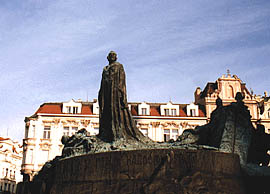
Advertisement on monuments covers the costs of repairs
 |
"All proceeds from the advertising, which is up during the reconstruction on scaffolding around the monument, will cover 100 percent of its restoration costs," said Rejchrt. The city then does not have to contribute a single penny. "I believe that this is how restorations of monuments are sponsored all over the world," said Pavel Filip, one of the restorers of the Jan Hus statue, to ČTK. According to him, entire cathedrals in Barcelona are covered in this way. "It works perfectly," he added.
Jan Kněžínek, the director of Prague's monument preservation office, shares the same opinion. "Every crown that goes into the restoration of monuments is good," he stated. According to him, there will never be enough money to restore all monuments.
The contract for the lease and restoration of the Jan Hus statue with the advertising agency Qeep was signed by the Gallery of the Capital City of Prague (GHMP). It has been criticized by councilor Milan Richter, who claims it is disadvantageous for the city. Furthermore, according to Richter, it is practically non-terminable. The councilor disapproves of the long duration of the monument's restoration, as well as the fact that the selection of the restorer is managed by the agency. The gallery can only terminate the agreement if the company goes bankrupt.
Petra Hoftichová from GHMP has a different view on the duration of the reconstruction. "When the gallery restores monuments itself, it takes longer," she told ČTK. The gallery does not have funds for repairs, and if they are spread over several seasons, costs increase. According to Hoftichová, the gallery receives about one million crowns annually for restorations. "Given that the budgets of some institutions are low, I don't know how we would carry out the work without grants and subsidies," Hoftichová stated. The gallery also receives additional funds from sponsors.
The time during which visitors to Prague do not see the monument could be shortened, according to Kněžínek, if the banners were removed when they are not being repaired. Breaks occur, according to him, for example, between the investigation and its processing. However, Kněžínek admits that dismantling the scaffolding could increase restoration costs.
Hoftlichová does not see a problem with the selection of restorers. They are chosen from a list from the Ministry of Culture, and according to Hoftichová, both the gallery and the monument conservators approve them. However, Kněžínek argues that their selection could be more transparent. "In any case, they are top-level experts," he added.
According to Richter, the process should be that the gallery selects a restorer through a competition and in another competition chooses a company that will provide advertising on the scaffolding. "There are about five licensed people in the republic; we use top restorers," Rejchrt added.
According to Rejchrt, the agency tries to implement the advertising as sensitively as possible. "As a background for the banner, we place the monument and add ten percent of the advertising message," Rejchrt explained. The companies that advertise on the banner are carefully selected. They must, according to Rejchrt, have a connection to the Czech Republic or Prague. They also consult with the city departments. According to him, the advertising looks better than when the monuments are covered in a "green cloth."
According to Kněžínek, the first monuments covered in advertising were in Venice. "Here, the history began five or six years ago with Saint Wenceslas at Wenceslas Square; that was the first swallow," Kněžínek said. According to him, the second monument to be covered was the eight-armed lamp at Hradčanské Square. The Qeep agency also collaborated on the restoration of the Palace near Hyberns. The gallery had some statues on Charles Bridge reconstructed from private sources.
However, some banners should still disappear from buildings in the center of Prague. Starting from September 1, this method of advertising is banned by the Prague magistrate. Only those that serve to cover construction modifications or repairs will be exempt.
The English translation is powered by AI tool. Switch to Czech to view the original text source.
1 comment
add comment
Subject
Author
Date
záminka
hoja
09.08.07 10:27
show all comments






